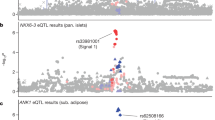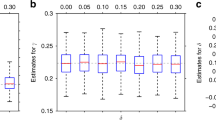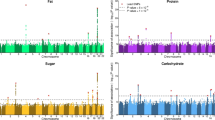Abstract
Genome-wide association studies (GWAS) of longitudinal birth cohorts enable joint investigation of environmental and genetic influences on complex traits. We report GWAS results for nine quantitative metabolic traits (triglycerides, high-density lipoprotein, low-density lipoprotein, glucose, insulin, C-reactive protein, body mass index, and systolic and diastolic blood pressure) in the Northern Finland Birth Cohort 1966 (NFBC1966), drawn from the most genetically isolated Finnish regions. We replicate most previously reported associations for these traits and identify nine new associations, several of which highlight genes with metabolic functions: high-density lipoprotein with NR1H3 (LXRA), low-density lipoprotein with AR and FADS1-FADS2, glucose with MTNR1B, and insulin with PANK1. Two of these new associations emerged after adjustment of results for body mass index. Gene–environment interaction analyses suggested additional associations, which will require validation in larger samples. The currently identified loci, together with quantified environmental exposures, explain little of the trait variation in NFBC1966. The association observed between low-density lipoprotein and an infrequent variant in AR suggests the potential of such a cohort for identifying associations with both common, low-impact and rarer, high-impact quantitative trait loci.
This is a preview of subscription content, access via your institution
Access options
Subscribe to this journal
Receive 12 print issues and online access
$209.00 per year
only $17.42 per issue
Buy this article
- Purchase on Springer Link
- Instant access to full article PDF
Prices may be subject to local taxes which are calculated during checkout





Similar content being viewed by others
References
Rantakallio, P. Groups at risk in low birth weight infants and perinatal mortality. Acta Paediatr. Scand. Suppl. 193, 43 (1969).
Jarvelin, M.R. et al. Early life factors and blood pressure at age 31 years in the 1966 northern Finland birth cohort. Hypertension 44, 838–846 (2004).
Varilo, T. & Peltonen, L. Isolates and their potential use in complex gene mapping efforts. Curr. Opin. Genet. Dev. 14, 316–323 (2004).
Service, S. et al. Magnitude and distribution of linkage disequilibrium in population isolates and implications for genome-wide association studies. Nat. Genet. 38, 556–560 (2006).
Manolio, T.A., Bailey-Wilson, J.E. & Collins, F.S. Genes, environment and the value of prospective cohort studies. Nat. Rev. Genet. 7, 812–820 (2006).
Laitinen, J., Pietilainen, K., Wadsworth, M., Sovio, U. & Jarvelin, M.R. Predictors of abdominal obesity among 31-y-old men and women born in Northern Finland in 1966. Eur. J. Clin. Nutr. 58, 180–190 (2004).
Pouta, A. et al. Manifestations of metabolic syndrome after hypertensive pregnancy. Hypertension 43, 825–831 (2004).
Taponen, S. et al. Metabolic cardiovascular disease risk factors in women with self-reported symptoms of oligomenorrhea and/or hirsutism: Northern Finland Birth Cohort 1966 Study. J. Clin. Endocrinol. Metab. 89, 2114–2118 (2004).
Saari, K.M. et al. A 4-fold risk of metabolic syndrome in patients with schizophrenia: the Northern Finland 1966 Birth Cohort study. J. Clin. Psychiatry 66, 559–563 (2005).
Heller, D.A., de Faire, U., Pedersen, N.L., Dahlen, G. & McClearn, G.E. Genetic and environmental influences on serum lipid levels in twins. N. Engl. J. Med. 328, 1150–1156 (1993).
Souren, N.Y. et al. Anthropometry, carbohydrate and lipid metabolism in the East Flanders Prospective Twin Survey: heritabilities. Diabetologia 50, 2107–2116 (2007).
Korkeila, M., Kaprio, J., Rissanen, A. & Koskenvuo, M. Effects of gender and age on the heritability of body mass index. Int. J. Obes. 15, 647–654 (1991).
Wessel, J. et al. C-reactive protein, an 'intermediate phenotype' for inflammation: human twin studies reveal heritability, association with blood pressure and the metabolic syndrome, and the influence of common polymorphism at catecholaminergic/beta-adrenergic pathway loci. J. Hypertens. 25, 329–343 (2007).
Alberti, K.G., Zimmet, P. & Shaw, J. Metabolic syndrome–a new world-wide definition. A Consensus Statement from the International Diabetes Federation. Diabet. Med. 23, 469–480 (2006).
Haffner, S.M. Relationship of metabolic risk factors and development of cardiovascular disease and diabetes. Obesity (Silver Spring) 14 (Suppl. 3), 121S–127S (2006).
Frayling, T.M. et al. A common variant in the FTO gene is associated with body mass index and predisposes to childhood and adult obesity. Science 316, 889–894 (2007).
Kathiresan, S. et al. Six new loci associated with blood low-density lipoprotein cholesterol, high-density lipoprotein cholesterol or triglycerides in humans. Nat. Genet. 40, 189–197 (2008a).
Loos, R.J. et al. Common variants near MC4R are associated with fat mass, weight and risk of obesity. Nat. Genet. 40, 768–775 (2008).
Ridker, P.M. et al. Loci related to metabolic-syndrome pathways including LEPR,HNF1A, IL6R, and GCKR associate with plasma C-reactive protein: the Women's Genome Health Study. Am. J. Hum. Genet. 82, 1185–1192 (2008).
Wellcome Trust Case Control Consortium. Genome-wide association study of 14,000 cases of seven common diseases and 3,000 shared controls. Nature 447, 661–678 (2007).
Willer, C.J. et al. Newly identified loci that influence lipid concentrations and risk of coronary artery disease. Nat. Genet. 40, 161–169 (2008).
Kathiresan, S., Musunuru, K. & Orho-Melander, M. Defining the spectrum of alleles that contribute to blood lipid concentrations in humans. Curr. Opin. Lipidol. 19, 122–127 (2008b).
Morin-Papunen, L. et al. Comparison of metabolic and inflammatory outcomes in women who used oral contraceptives and the levonorgestrel-releasing intrauterine device in a general population. Am. J. Obstet. Gynecol. 199, 529.e1–529.e10 (2008).
Barker, D.J., Osmond, C., Forsen, T.J., Kajantie, E. & Eriksson, J.G. Trajectories of growth among children who have coronary events as adults. N. Engl. J. Med. 353, 1802–1809 (2005).
Tzoulaki, I. et al. Size at birth, weight gain over the life course, and low-grade inflammation in young adulthood: northern Finland 1966 Birth Cohort study. Eur. Heart J. 29, 1049–1056 (2008).
Kajantie, E., Barker, D.J., Osmond, C., Forsen, T. & Eriksson, J.G. Growth before 2 years of age and serum lipids 60 years later: the Helsinki Birth Cohort study. Int. J. Epidemiol. 37, 280–289 (2008).
Helgason, A., Yngvadottir, B., Hrafnkelsson, B., Gulcher, J. & Stefansson, K. An Icelandic example of the impact of population structure on association studies. Nat. Genet. 37, 90–95 (2005).
Bacanu, S.A., Devlin, B. & Roeder, K. Association studies for quantitative traits in structured populations. Genet. Epidemiol. 22, 78–93 (2002).
Maniatis, N. et al. The first linkage disequilibrium (LD) maps: delineation of hot and cold blocks by diplotype analysis. Proc. Natl. Acad. Sci. USA 99, 2228–2233 (2002).
Aulchenko, Y.S. et al. Loci influencing lipid levels and coronary heart disease risk in 16 European population cohorts. Nat. Genet. advance online publication, doi:10.1038/ng.269 (7 December 2008).
Cohen, J.C. et al. Multiple rare alleles contribute to low plasma levels of HDL cholesterol. Science 305, 869–872 (2004).
Zelcer, N. & Tontonoz, P. Liver X receptors as integrators of metabolic and inflammatory signaling. J. Clin. Invest. 116, 607–614 (2006).
Wu, F.C. & von Eckardstein, A. Androgens and coronary artery disease. Endocr. Rev. 24, 183–217 (2003).
Schaeffer, L. et al. Common genetic variants of the FADS1 FADS2 gene cluster and their reconstructed haplotypes are associated with the fatty acid composition in phospholipids. Hum. Mol. Genet. 15, 1745–1756 (2006).
Prokopenko, I. et al. Variants in MTNR1B influence fasting glucose levels. Nat. Genet. advance online publication, doi:10.1038/ng.290 (7 December 2008).
Ramaswamy, G., Karim, M.A., Murti, K.G. & Jackowski, S. PPARalpha controls the intracellular coenzyme A concentration via regulation of PANK1alpha gene expression. J. Lipid Res. 45, 17–31 (2004).
Zhang, Y.M. et al. Chemical knockout of pantothenate kinase reveals the metabolic and genetic program responsible for hepatic coenzyme A homeostasis. Chem. Biol. 14, 291–302 (2007).
NCI-NHGRI Working Group on Replication in Association Studies et al. Replicating genotype-phenotype associations. Nature 447, 655–660 (2007).
Lasky-Su, J. et al. On the replication of genetic associations: timing can be everything! Am. J. Hum. Genet. 82, 849–858 (2008).
Klei, L., Luca, D., Devlin, B. & Roeder, K. Pleiotropy and principal components of heritability combine to increase power for association analysis. Genet. Epidemiol. 32, 9–19 (2008).
Katoh, S. et al. Genetic and environmental effects on fasting and postchallenge plasma glucose and serum insulin values in Finnish twins. J. Clin. Endocrinol. Metab. 90, 2642–2647 (2005).
Hottenga, J.J., Whitfield, J.B., de Geus, E.J., Boomsma, D.I. & Martin, N.G. Heritability and stability of resting blood pressure in Australian twins. Twin Res. Hum. Genet. 9, 205–209 (2006).
Bodmer, W. & Bonilla, C. Common and rare variants in multifactorial susceptibility to common diseases. Nat. Genet. 40, 695–701 (2008).
Tobin, M.D., Sheehan, N.A., Scurrah, K.J. & Burton, P.R. Adjusting for treatment effects in studies of quantitative traits: antihypertensive therapy and systolic blood pressure. Stat. Med. 24, 2911–2935 (2005).
Purcell, S. et al. PLINK: a tool set for whole-genome association and population-based linkage analyses. Am. J. Hum. Genet. 81, 559–575 (2007).
Zaitlen, N., Kang, H.M., Eskin, E. & Halperin, E. Leveraging the HapMap correlation structure in association studies. Am. J. Hum. Genet. 80, 683–691 (2007).
Browning, S.R. & Browning, B.L. Rapid and accurate haplotype phasing and missing-data inference for whole-genome association studies by use of localized haplotype clustering. Am. J. Hum. Genet. 81, 1084–1097 (2007).
Benjamini, Y. & Hochberg, Y. Controlling the false discovery rate: a practical and powerful approach to multiple testing. J. R. Stat. Soc. Ser. A 57, 289–300 (1995).
Donoho, D. & Jin, J. Higher criticism for detecting sparse heterogeneous mixtures. Ann. Statist. 32, 962–994 (2004).
Bouatia-Naji, N. et al. A polymorphism within the G6PC2 gene is associated with fasting plasma glucose levels. Science 320, 1085–1088 (2008).
Acknowledgements
We acknowledge the support of US National Heart, Lung, and Blood Institute grant HL087679 through the STAMPEED program, grants MH083268, GM053275-14 and U54 RR020278 from the US National Institutes of Health, grant DMS-0239427 from the National Science Foundation, the Medical Research Council of the UK, EURO-BLCS, QLG1-CT-2000-01643 and the European Community's Seventh Framework Programme (FP7/2007-2013), ENGAGE project and grant agreement HEALTH-F4-2007-201413. The authors would like to thank the Center of Excellence in Common Disease Genetics of the Academy of Finland and Nordic Center of Excellence in Disease Genetics, the Sydantautisaatio (Finnish Foundation of Heart Diseases), the Broad Genotyping Center, D. Mirel, H. Hobbs, J. DeYoung, P. Rantakallio, M. Koiranen and M. Isohanni for advice and assistance.
Author information
Authors and Affiliations
Contributions
The study was designed by L.P., N.B.F., C.S., M.I.M., M.J.D., P.E., M.-R.J. and S.K.S. Information on traits was collected and maintained by M.-R.J., A.-L.H., A.P., A.R. and J.L. Genotyping was supervised by S.G. Database support was provided by H.T., U.S. and M.K. Statistical analysis was performed by C.S., S.K.S., A.C., C.G.J., J.B., N.A.Z., and M.J.D. S.R., E.J. and T.V. contributed to the analysis of the Finnish genetic signature. L.C., C.H. and P.E. participated in discussion of results. The manuscript was written by C.S., S.K.S., N.B.F. and L.P. All authors reviewed the manuscript.
Corresponding authors
Supplementary information
Supplementary Text and Figures
Supplementary Figures 1–8, Supplementary Tables 1–5 and Supplementary Note (PDF 1154 kb)
Rights and permissions
About this article
Cite this article
Sabatti, C., Service, S., Hartikainen, AL. et al. Genome-wide association analysis of metabolic traits in a birth cohort from a founder population. Nat Genet 41, 35–46 (2009). https://doi.org/10.1038/ng.271
Received:
Accepted:
Published:
Issue Date:
DOI: https://doi.org/10.1038/ng.271
This article is cited by
-
Association of the ANGPTL3 gene polymorphisms and haplotypes with cardiovascular diseases in Birjand longitudinal aging study (BLAS)
Egyptian Journal of Medical Human Genetics (2022)
-
Genome-wide DNA methylation profiling in anorexia nervosa discordant identical twins
Translational Psychiatry (2022)
-
A Nutrigenetic Update on CETP Gene–Diet Interactions on Lipid-Related Outcomes
Current Atherosclerosis Reports (2022)
-
A multi-omics study of circulating phospholipid markers of blood pressure
Scientific Reports (2022)
-
Analysis of rare genetic variation underlying cardiometabolic diseases and traits among 200,000 individuals in the UK Biobank
Nature Genetics (2022)



